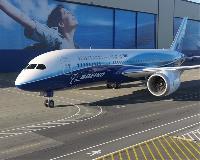Boeing [NYSE:BA] announced that first flight of the 787 has been moved from the end of the first quarter of this year to around the end of the second quarter to provide additional time to complete assembly of the first airplane. Deliveries are now expected to begin in early 2009, rather than late 2008.
„The fundamental design and technologies of the 787 remain sound,“ said Scott Carson, president and CEO of Boeing Commercial Airplanes. „However, we continue to be challenged by start-up issues in our factory and in our extended global supply-chain.“
Carson said that while solid progress has been made on the assembly of Airplane #1, the rate at which jobs are being completed has not improved sufficiently to maintain the current schedule.
„Our revised schedule is based upon updated assessments from the 787 management team of the progress we have made and the lessons we have learned to date. This includes our experience on the factory floor completing production work on the airplane that was originally intended to be done by our suppliers,“ Carson said.
Over the next several weeks, Boeing will be working with its customers and suppliers to assess the specific impacts of the schedule change on the 787’s flight test program and entry into service. This effort will include an assessment of supplier progress in meeting their commitments to deliver more complete assemblies on subsequent airplanes.
„We are deeply disappointed by what this delay means for our customers, and we are committed to working closely with them as we assess the impact on our delivery schedules,“ Carson said.
Under 787 Vice President and General Manager Pat Shanahan, who assumed leadership of the 787 program last October, Boeing has provided additional resources to more effectively manage the 787 global supply chain. The company has assembled a team of experienced executives, business managers and planning specialists that will be based at the supplier partners, as well as in its own final assembly facility.
„We have brought together the right skills and leadership from around the company to ensure a successful start-up of our global production system,“ said Shanahan. „We have put the people, structure and processes in place to execute our plan and we will take additional steps to strengthen our team if needed. We have made significant progress in reducing parts shortages, improving fastener availability and achieving static and systems test milestones. We are focused on getting the 787 flying, certified and delivered to our customers.“
Boeing’s 2008 financial guidance will be updated with the impact of these changes when the company holds its fourth-quarter 2007 earnings conference call on January 30. There will be no impact from the schedule change on 2007 financial results and the company does not expect the impact on 2008 earnings guidance to be significant. Financial guidance for 2009 now will be provided when the company issues its first quarter 2008 earnings report in late April, which will follow the assessment of the impact of 787 schedule changes. The company continues to expect strong earnings per share growth in 2009. The outlook for the company’s defense business and in-production commercial airplane programs remains very strong.
Boeing will hold a conference call with Scott Carson and Pat Shanahan to discuss the 787 schedule changes today at 11:00 a.m. EST, 8:00 a.m. PST. The call will be accessible by clicking here.
Certain statements in this report may constitute „forward-looking“ statements within the meaning of the Private Securities Litigation Reform Act of 1995. Words such as „expects,“ „intends,“ „plans,“ „projects,“ „believes,“ „estimates,“ and similar expressions are used to identify these forward-looking statements. These statements are not guarantees of future performance and involve risks, uncertainties and assumptions that are difficult to predict. Forward-looking statements in this press release include, among others, statements regarding future results as a result of our growth and productivity initiatives, our 2007 and 2008 financial outlook and the benefits of the IDS structure. Forward-looking statements are based upon assumptions as to future events that may not prove to be accurate. Actual outcomes and results may differ materially from what is expressed or forecasted in these forward-looking statements. As a result, these statements speak only as of the date they were made and we undertake no obligation to publicly update or revise any forward-looking statements, whether as a result of new information, future events or otherwise. Our actual results and future trends may differ materially depending on a variety of factors, including the continued operation, viability and growth of major airline customers and non-airline customers (such as the U.S. Government); adverse developments in the value of collateral securing customer and other financings; the occurrence of any significant collective bargaining labor dispute; our successful execution of internal performance plans including our company-wide growth and productivity initiatives, production rate increases and decreases (including any reduction in or termination of an aircraft product), availability of raw materials, acquisition and divestiture plans, and other cost-reduction and productivity efforts; charges from any future SFAS No. 142 review; ability to meet development, production and certification schedules for the 787 program and the ability to meet scheduled deliveries of the 787 airplane; technical or quality issues in development programs (affecting schedule and cost estimates) or in the satellite industry; an adverse development in rating agency credit ratings or assessments; the actual outcomes of certain pending sales campaigns and U.S. and foreign government procurement activities, including the uncertainty associated with the procurement of tankers by the U.S. Department of Defense (DoD) and funding of the C-17 program; the cyclical nature of some of our businesses; unanticipated financial market changes which may impact pension plan assumptions; domestic and international competition in the defense, space and commercial areas; continued integration of acquired businesses; performance issues with key suppliers, subcontractors and customers; significant disruption to air travel worldwide (including future terrorist attacks); global trade policies; worldwide political stability; domestic and international economic conditions; price escalation; the outcome of political and legal processes, changing priorities or reductions in the U.S. Government or foreign government defense and space budgets; termination of government or commercial contracts due to unilateral government or customer action or failure to perform; legal, financial and governmental risks related to international transactions; legal and investigatory proceedings; tax settlements with the IRS and various states; U.S. Air Force review of previously awarded contracts; costs associated with the exit of the Connexion by Boeing business; and other economic, political and technological risks and uncertainties. Additional information regarding these factors is contained in our SEC filings, including, without limitation, our Annual Report on Form 10-K for the year ended December 31, 2006 and our Quarterly Report on Form 10-Q for the quarters ended March 31, 2007, June 30, 2007 and September 30, 2007.
Photo: Boeing






